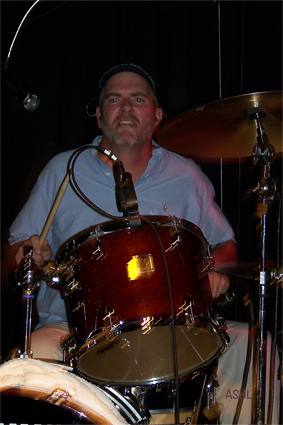BIOGRAPHY - Dave Harrison, Percussion, Drums, Loop Programming

Dave Harrison - Producer/Musician
Dave Harrison is well-known as an extremely talented musician
in his own right. We are
preparing an in-depth biography about his musical accomplishments.
However, until that is finished, you may enjoy reading an interview from several
years ago... found on Edwin.com several years ago. Have fun, and
watch for an updated Bio soon! Thanks for your patience! REMEMBER,
this is an old article...
YAMAHA BIRCH CUSTOM
(Absolute Plum Finish)
22" X 16" kick drum
12" X 10" tom
14" X 12" tom
16" X 14" tom
14" X 6 1/2" maple snare
drum
14" X 3" brass snare
drum
cymbals: ZILDJIAN
20" K custom ride
19" K thin dark crash
(brilliant)
18" A thin crash
17" K thin dark crash
(brilliant)
20" A swish (w/3 rivets)
14" A bottom hi-hat
(brilliant)
14" K special dark top
hi-hat
sticks: VIC FIRTH
DRUMSTICKS, INC.
American classic 5a or
5b wood tips
rakes, brushes, bams,
mallets
electric and misc.
percussion:
DRUM KAT 3.8 midi controller
ROLAND R-8 drum machine
AKAI S-2000 sampler
AFRO conga and tumba
I
started studying percussion in fifth grade and I continued through high school
and college. I picked up my degree from West Virginia University. I studied
with Gary Chaffee in Boston for a short period of time. I also studied with
Rande Sanderbeck. I studied general percussion with Phil Faini at WVU. He has
always been a huge influence.
That
continues to help me because I have a pretty deep well from which to draw.
This especially helps me in the studio. It just gives me a lot of depth.
I met
Edwin when Craig was playing with them before they got signed. They came by
the Exit/In in Nashville. Craig called and said that they were playing the
next night and to come on by. So, I brought a bunch of percussion stuff and
sat in. Later, they called me on a Tuesday night and said, 'Can you be in
Cincinnati tomorrow with the show learned, no rehearsal and go for two weeks?'
And I said, 'Yeah, absolutely.' We started a great musical and personal
friendship.
- What CDs would
someone currently find in your changer?
Francis Dunnery’s "Let’s
Go Do What Happens" — an epic
Kid Rock — are you
kidding me or what?
Elvis Costello’s "Mighty
as a Rose" — Jim Keltner is so slinky
Sheriff
Reno Hamilton — my buddy Eric Hamilton drinking moonshine and doing bluegrass
versions of The Cars, Jimi Hendrix, Led Zeppelin — killer stuff
Tom Petty’s
"Wildflowers" — distilled simplicity — Steve Ferrone is a genius
My
earliest influence as a drummer was Nigel Olsson who played with the Elton
John band all through the 70's. Anything Elton John is cool with me. I think
he is the greatest songwriter ... of my generation, anyway. Especially the
stuff in the 70’s. It's very similar to our situation. It was marketed as
Elton John, but it was very much a band. It was always the same guys. They
played on all the records, they did all the vocals. They didn't bring in
session players. They stayed intact for a decade. As I became interested in
other styles of music, I discovered other drummers like David Garibaldi from
Tower of Power, Steve Gadd, Ritchie Hayward and Steve Ferrone from the Average
White Band.
-
Throughout the years, you have collected and enjoyed playing many different
kinds of funky percussion instruments. In fact, there was even a garden weasel
played on the Misguided Roses album. What kind of great percussion surprises
are on the Messenger CD?
I play a
cajone — which is a Peruvian instrument. You can hear that on the down beats
and the back beats on "Ghosts of Jackson Square" and on the loop for "I Could
Not Ask For More." The cajone is basically a plywood box, but it has one side
that is very thin where you get your bottom end, and the other side is for the
top end. I played the udu as well — which is a clay pot. I also purchased a
shakere. I play that on "See off this Mountain" and "Wish In This World."
- If you were to write
an autobiography, what would it be titled?
Drum Luck
- How was the studio
experience different for Messenger than it was for Misguided Roses?
With
Messenger, it was different in that we had a much clearer idea of how we
wanted to make the record. We made Misguided Roses for the most part in Matt
Rollings’ basement. So for me, the biggest change was having a drum room. And
that makes all the difference in the world. We miked the drums like we
normally do — with overhead mics and closed mics on each component. And we
also miked the drums at 25 feet and 35 feet away. It was a little more
professional. We had a wealth of resources at our fingertips. Another huge
thing for us was having Bob Clearmountain booked in advance to mix the CD.
I also
give tremendous credit to Rich Crabtree and Dean Harrison (Harrington
Management) for creating the environment for making the kind of record that we
wanted to make. That is not easy to do. They really worked hard to put all of
the pieces into place so that we could make this record.
Dave Harrison
was born and raised in West Virginia. He graduated from West Virginia University
with a degree in applied music. He currently lives in Nashville, TN and plays
double bogey golf.

|